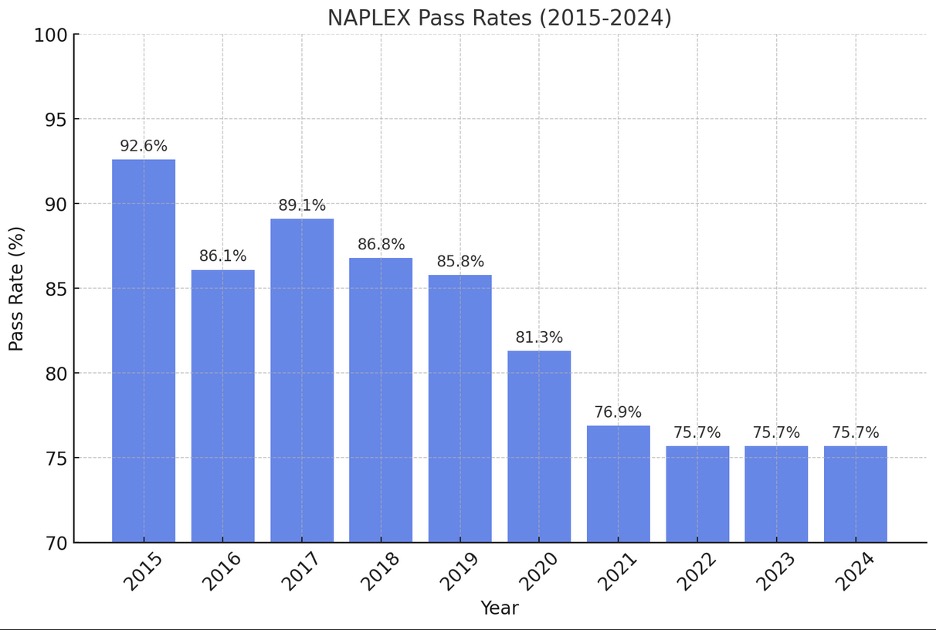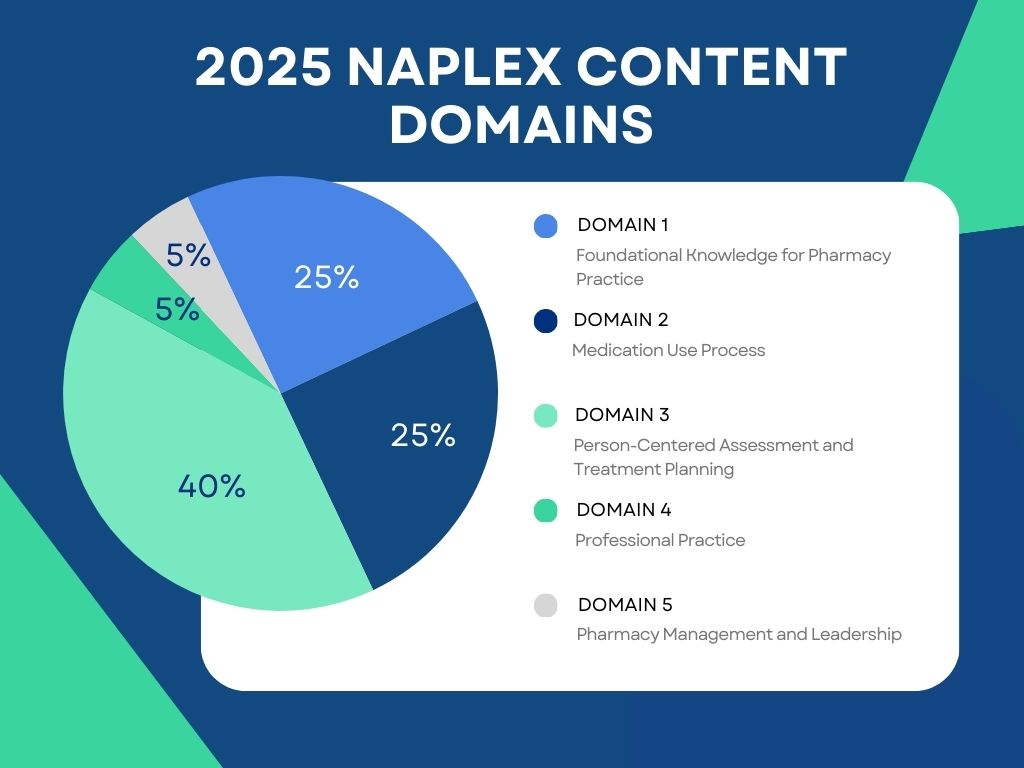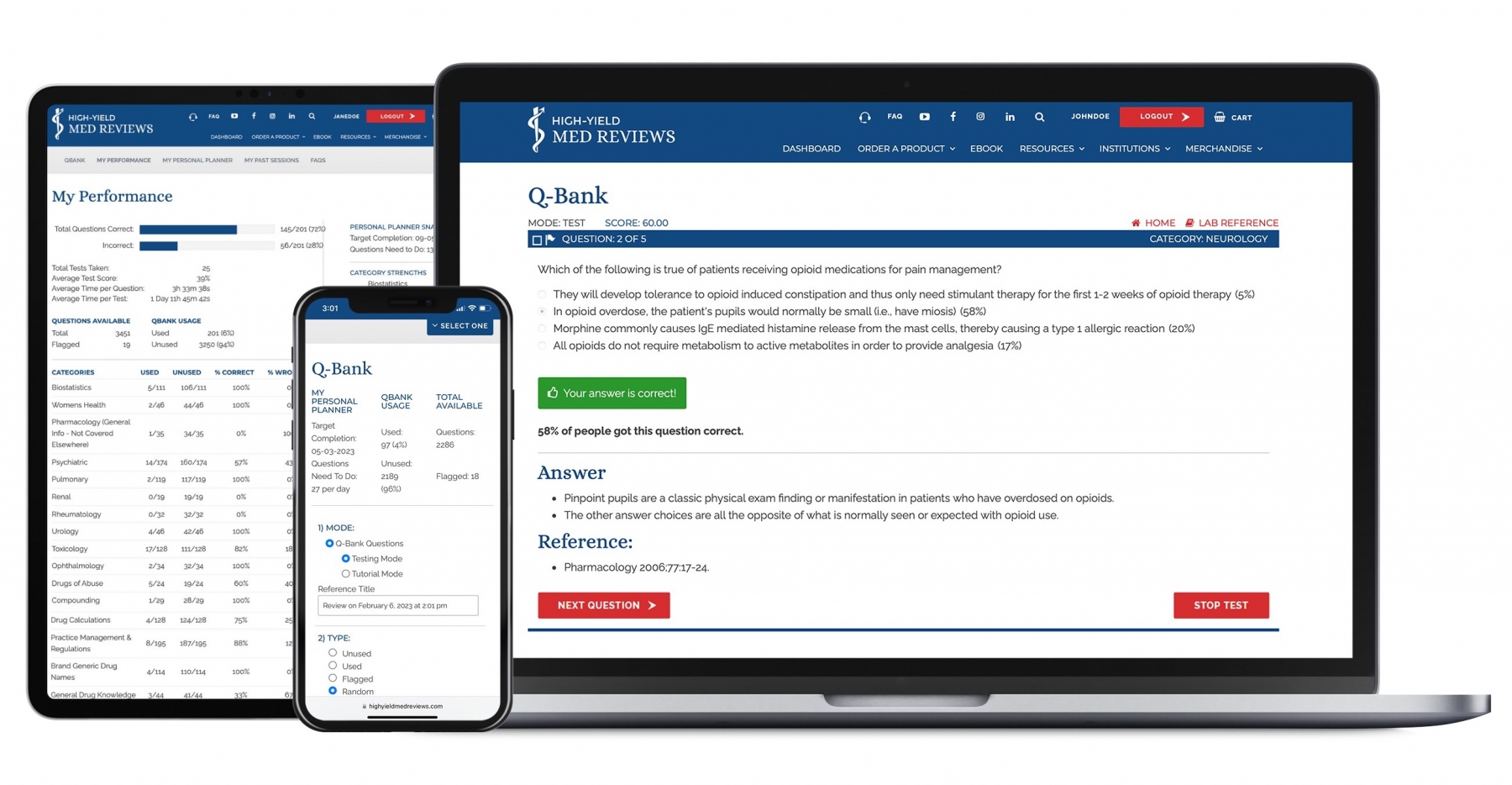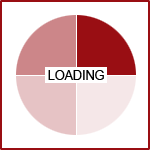How to Pass the NAPLEX Exam
What you need to know about the NAPLEX Exam
There is a lot of uncertainty and confusion surrounding the trends, changes, and scoring of the NAPLEX Exam (The North American Pharmacist Licensure Examination). This is a critical hurdle to beginning a career in pharmacy. However, many pharmacy students are approaching the exam inadequately prepared and find themselves startled and dismayed when they receive a failing score. Years of schooling and investment add up to nothing if a pharmacy student doesn't succeed in attaining licensure by passing the NAPLEX exam. They cannot practice as a licensed pharmacist without it.
We are going to cover 3 key questions for today's pharmacy student preparing for the NAPLEX Exam.
- Why have scores dropped so dramatically over the last 10 years?
- What has changed in the new content outline for 2025?
- What does a minimum scaled score of 75 mean?
Finally, we will give you a roadmap for ensuring you are prepared for success on the NAPLEX.
Part 1: naplex Scores have plummeted
For years and years, NAPLEX pass rates hovered around 95% annually and the number of pharmacy schools was small and selective. Getting into pharmacy school was a high bar and those that did generally passed the exam on their first try.
In 2015 that began to change with a slight decline. And each year, the outcomes were a little worse than the year before.
The last three years of first-time pass rates have hovered at 75%. This means that 1-in-4 pharmacy students graduate from an accredited pharmacy program and fail their licensure exam!

The reasons for this downward trend are varied and debated, but most experts agree that the swift and dramatic increase in the number of accredited pharmacy programs is one of the primary factors. This resulted in more available seats, allowing students who previously might not have secured admission to enter the pharmacy track under lower admission standards. Some programs began offering accelerated pathways to compete for the talent pool of available students giving those students less time to learn the immense amount of material. It is unclear whether the level of preparation provided by the influx of new programs meets the standards of traditional pharmacy programs.
- 2000: There were 82 pharmacy schools in the U.S.
- 2010: A rapid expansion led to 120+ accredited schools.
- 2024: Currently, there are 140+ accredited pharmacy schools.
What does this mean for you?
If you want to pass your NAPLEX Exam the first time and begin your pharmacy career without delay, you will need to do more to ensure you are exam-ready. Being successful in pharmacy school does not mean you will be successful on the NAPLEX Exam.
Part 2: The new 2025 NABP NAPLEX content outline
What has stayed the same
- The exam continues to be 225 questions with a testing time of 6 hours.
- The largest section of both outlines focused on drugs, patient-focused treatment plans and the therapeutic application of pharmacology.
- Core items like calculations are included but have moved to a different section of the blueprint.
What has changed
- The exam outline is organized into 5 larger areas instead of 6 with no specific breakdown of how the subdomains will be represented within the domain.

Domain 1: Foundational Knowledge for Pharmacy Practice (25% of Exam)
This domain covers the essential scientific and clinical knowledge required for effective pharmacy practice.
- Subdomains: Covers pharmacology, pharmacokinetics, pharmacodynamics, pharmacogenomics, and pharmaceutics.
- Pharmaceutical Sciences: Covers pharmacology, pharmacokinetics, pharmacodynamics, pharmacogenomics, and pharmaceutics.
- Compounding & Formulations: Includes both sterile and nonsterile pharmaceutical preparations.
- Pharmaceutical Calculations: Encompasses drug dosages, concentrations, administration rates, conversions, nutritional needs, and pharmacokinetic measures.
- Drug Development & Research: Focuses on clinical trial phases, emergency use authorizations, research design, biostatistics, and ethics.
- Medical Literature & Data Interpretation: Involves retrieving, assessing, and interpreting primary, secondary, and tertiary resources.
Domain 2: Medication Use Process (25% of Exam)
Focuses on the steps involved in ensuring safe and effective medication therapy.
- Subdomains:
- Prescription and Medication Orders: Includes drug names, indications, dosing, dosage forms, safety considerations, and prescription regulations.
- Therapeutic Substitutions: Covers formulary restrictions, therapeutic alternatives, medication shortages, and biosimilars.
- Immunization Services: Focuses on indications, scheduling, contraindications, storage, administration techniques, and adverse reactions.
- Medication Handling & Disposal: Addresses storage, stability, disposal of hazardous/nonhazardous drugs, controlled substances, and temperature control.
Domain 3: Person-Centered Assessment and Treatment Planning (40% of Exam)
Focuses on person-centered assessments, individualized treatment planning, and safe medication use, with attention to therapy appropriateness, drug interactions, and patient education.
- Subdomains:
- Patient Health Assessment: Medication and allergy history, health conditions, screenings, and assessments.
- Therapy Evaluation: Appropriateness of therapy (medications, immunizations, non-drug therapies), drug interactions, and errors/omissions.
- Therapeutic Monitoring: Goals, clinical endpoints, safety, effectiveness, and follow-up.
- Patient Education: Lifestyle changes, medication use/storage, disease management, and health maintenance.
- Over-the-Counter Medications & Devices: OTC medications, dietary supplements, and medication administration/self-monitoring tools.
Domain 4: Professional Practice (5% of Exam)
Emphasizes the ethical and professional standards expected in pharmacy practice.
- Subdomains:
- Reporting & Public Health: Adverse drug event and medication error reporting, public health initiatives, and risk-prevention programs.
- Social Determinants & Ethics: Social drivers of health and ethical considerations, including informed consent, confidentiality, and professional responsibility.
Domain 5: Pharmacy Management and Leadership (5% of Exam)
Focuses on pharmacy operations, quality improvement, and mentorship.
- Subdomains:
- Pharmacy Operations & Safety: Operational planning, risk management, regulations, technology, error prevention, and medication safety.
- Inventory & Quality Improvement: Inventory management, drug recalls, shortages, and continuous quality improvement activities.
- Mentorship & Feedback: Mentorship, preceptorship, and providing/receiving feedback in work activities.
What does this mean for you?
The categories are still very broad and encompass huge content areas. You must be prepared to answer questions across all areas of pharmacy study. Questions will vary in difficulty and complexity, requiring you to be prepared for both direct content questions and challenging, potentially confusing case-based scenarios. The key is understanding concepts, not trying to memorize information. As you study, ask yourself "why" to see if you really grasp the underlying concept that will allow you to answer dozens of related questions. In other words, can you justify why a particular drug or treatment is the best option in a given scenario rather than simply stating the answer? If so, you'll be better prepared to tackle a variety of related questions and avoid being misled by deceptive answer choices.
PART 3: NAPLEX Passing Scores
The NABP scoring method for the NAPLEX Exam is a bit like trying to look behind the the Wizard of Oz's green curtain. A Passing score on the NAPLEX Exam is 75. But don't rush to an assumption on what that means.
- It does NOT mean a score of 75% correct.
- It does NOT mean 75 correctly answered questions.
- It does NOT mean a score of 75 out of a total possible score of 150 equals 50% correct.
These are the kinds of assumptions that lead pharmacy students to feel over-confident in their preparation only to be shocked when they receive a failing score. Remember, 1 in 4 test takers fail this exam on the first try. It is better to assume the test is difficult to pass than to assume you can easily meet the standard.

Let's see what the NABP explicitly tells us about the scoring:
The NAPLEX exam results are scored using an item response theory model. This model uses characteristics of the test questions and the candidate's correct and incorrect responses to calculate a "true score." These scores are converted into a scaled score relative to a passing threshold (which is assigned a score of 75). It is important to understand that scaled scores are neither percentiles nor percentages of correctly answered items. Candidates who meet or exceed this threshold receive a pass result (75-150). Those below this threshold receive a fail result (0-74).
This is one of the exceedingly confusing and frustrating things about the NABP NAPLEX scoring. Different questions are scored with different weights based on characteristics. What exactly does that mean? They do not say. They do say that the score does NOT represent a percentage or percentiles. Therefore, in addition to saying a score of 75 does not mean 75%, we would also say that a passing score of 75-150 does not mean 50-100% correct.
What does this mean for you?
We have been successfully preparing students for success on the NAPLEX Exam for nearly 20 years, we even have a pass guarantee that is based on our experience and user data. We guarantee that a user who completes 95% of the Q-Bank questions or more with a minimum of 70% correct will pass their exam the first time. This is our standard because it has been our experience that students who meet this criterion inevitably pass the exam.
A Roadmap for Success on the NAPLEX
You've dedicated years to your education and proven yourself as a successful student. Now, you face one final, crucial hurdle before launching your career. How can you ensure you're fully prepared?
The answer is, to train for exam success. Passing a 6-hour board exam is not the same thing as being successful in the classroom or the clinic. Being prepared for clinical practice is of critical importance, but you will never get the opportunity to put those skills into practice if you don't first pass the exam. You are preparing to take a multiple-choice question exam, and this is what you must train for. This means answering questions. Lots of them. You must take all the pharmacy knowledge you've attained in school and practice applying it to multiple-choice questions. This is a different skill!

An Olympic swimmer might spend time in the weight room and do yoga to increase flexibility, but at the end of the day, the primary focus will be swimming lap upon lap in the pool. They train for what they are expected to do on race day. You need to do the same. Train for the most important multiple-choice exam of your life by doing hundreds and hundreds of reps practicing multiple-choice questions.
Purchase a high-quality NAPLEX question bank with at least 2,000 questions and begin doing them daily. When you miss a question, don't just move on. Look at the rationale and ensure you can explain "why" the right answer is right and the wrong answer is wrong. (Pro tip: look at the High-Yield Core Concept if you are using our Q-Bank.) Being able to explain the "why" demonstrates you have gained the conceptual understanding that will apply to dozens of questions rather than a single answer to a single question.
Use the data from your practice questions. Identify the subject areas where you are weakest and revisit those topics. (Pro tip: The High-Yield Q-Bank includes the "My Performance" tool that serves as a living report card based on your individual user data). Use quality resources to review concepts where you are weakest. This might include lectures from thisiswhy.health, textbooks, or notes from your professors. As your test date approaches, dedicate a day to taking a full-length practice exam. This will help you build stamina for the six-hour test and assess your performance. High-Yield offers a full-length 225-question practice exam as part of our Essentials NAPLEX Preparation Course. We believe that students who score at least 70-75% on our exam can feel confident in their ability to succeed on the NAPLEX exam. This is a good benchmark for preparedness.

You can be ready for success on the NAPLEX. Start early. Practice what you will be doing, answering multiple-choice questions. Fill in your learning gaps with reliable teaching resources. Gauge your readiness with a full-length practice exam. Enter your exam with tested confidence, not blind arrogance, and you'll be on your way to starting your hard-earned career as a licensed pharmacist.


